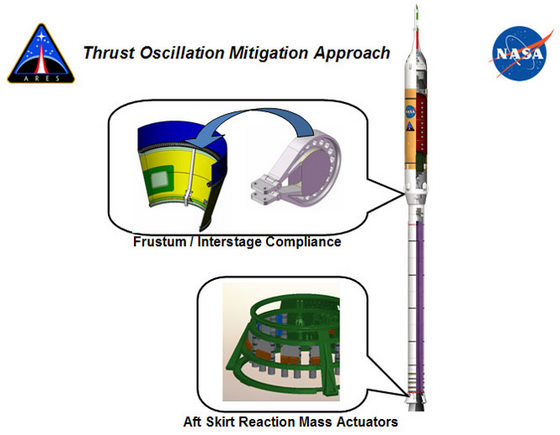[/caption]
NASA will add a system engineers equated to shock absorbers to Ares 1 rockets to reduce significant vibrations that could shake the Orion spacecraft and astronaut crews during early stages of the flight. Earlier, engineers had determined that at about 115 seconds into the flight, the Ares rocket would vibrate for about 5 seconds, enough to potentially make it difficult for crews to read console displays. To mitigate what's called thrust oscillation, engineers have proposed an active tuned mass absorber that would detect the frequency and amplitude of the thrust oscillation with accelerometers and internal pressure sensors, and use battery-powered motors to move spring mounted weights up and down to damp the vibration out. A spring-and-damper ring will separate the first and second stages of the rocket, and 16 actuators that act like shock absorbers will be added to the bell-shaped aft skirt at the bottom of the rocket.
Engineers are also looking to use a passive "compliance structure" which is a spring-loaded ring that would detune the stack by softening the interface between the first and upper stages while preserving lateral stability in the Ares 1 design concept.
This concept is expected to reduce the G-forces on the astronauts from about 5 G's to .25 G's.
Computer modeling and early design analyses showed the Ares 1 rocket would shake near 105-115 seconds into the flight after liftoff, subjecting the Orion spacecraft and astronauts onboard to high G forces for only about 5 seconds. But NASA engineers were concerned that astronauts could be injured or critical systems could be damaged during that time of the flight.
The thrust oscillation occurs as solid fuel in the first stage depletes, leaving a long, empty shell that takes on the characteristics of an organ pipe, resonating, at frequencies between 12 and 14 hertz. The second stage of the rocket and the Orion spacecraft atop it will naturally dampen the resulting pressure pulses, which essentially would jackhammer the astronauts and make it difficult for them to read console displays and respond.
Source: NASA news conference.
 Universe Today
Universe Today
